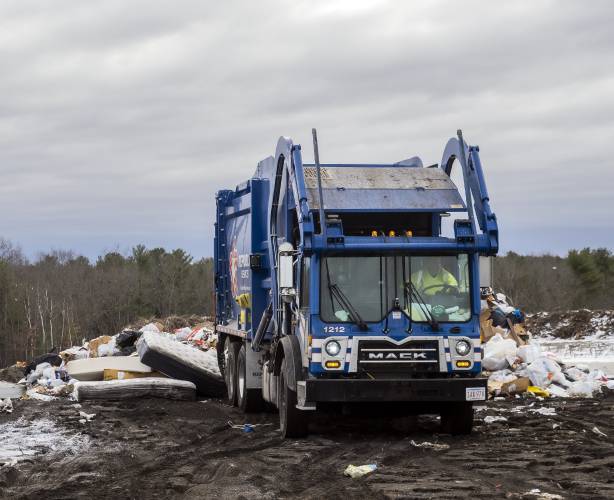Records reveal industry feedback shaped New Hampshire's Solid Waste rules

A refuse truck backs up to dump trash at the Nashua landfill.
|
Published: 07-08-2024 8:30 AM
Modified: 07-10-2024 4:45 PM |
New Hampshire’s proposed solid waste rules face a critical checkpoint before reaching legislative offices – a review by the Waste Management Council, an advisory body to the state agency primarily composed of members from the waste industry.
After many revisions, the final draft of the rules came under fire from environmental advocates, residents, and some legislators who argue that the rules are too lenient and could jeopardize public health and the environment.
Moreover, they feel the industry’s influence on the rules has been disproportionate.
Michael Wimsatt, director of the waste management division at the DES, explained that the rulemaking process began with a draft proposal presented to the Waste Management Council in January.
“They [the council] did express significant concerns with the rules, and we did make some changes in response to it because we had already recognized that there were some issues that needed to be addressed,” said Wimsatt.
This council should ideally consist of 13 members. Yet, it currently operates with five vacant seats, missing crucial representation from the public interest, public health experts, an elected official and the business or financial community.
Of the eight members serving, three have direct ties to the waste management industry.
Eric Steinhauser represents Sanborn Head and Associates Inc., the engineering firm providing technical expertise for Casella’s proposed landfill in Dalton. Daniel Sweet represents private industries generating hazardous waste. The third represents Pinard Waste Systems, a waste collection company.
Article continues after...
Yesterday's Most Read Articles
 Reclaiming Healy Park: A symbol of renewal and a reckoning with homelessness in Concord
Reclaiming Healy Park: A symbol of renewal and a reckoning with homelessness in Concord
 Home buying gets tougher as prices in New Hampshire continue to rise, outpacing national increase
Home buying gets tougher as prices in New Hampshire continue to rise, outpacing national increase
 Boutwell’s is now the biggest candlepin center in the state
Boutwell’s is now the biggest candlepin center in the state
 Suspect in Hampton Beach shooting arrested in Deerfield following police pursuit and shelter-in-place order
Suspect in Hampton Beach shooting arrested in Deerfield following police pursuit and shelter-in-place order
 Pedestrian struck in Pittsfield, officials treat death as suspicious
Pedestrian struck in Pittsfield, officials treat death as suspicious
 Concord school leaders grapple with lunch debt exceeding $100,000
Concord school leaders grapple with lunch debt exceeding $100,000
In a letter to the state agency, Sweet, the council’s vice chairman, defended existing landfill construction and control practices, arguing that the proposed rules would drastically alter them without “compelling statutory, regulatory, or scientific justification.”
Sweet emphasized that the proposed regulations would “negatively impact both current and future operations at the state’s privately owned solid waste handling facilities, without delivering a clear and demonstrable environmental benefit.”
This letter was sent just two days after the council received comments from Waste Management of New Hampshire Inc., the operator of New England’s largest landfill in Rochester, objecting to the draft rules.
“The WMNH objection raises several issues the Council would like the Division to address directly,” Sweet wrote.
DES can file the proposed rules as they stand even if it receives a formal objection from the council.
But Wimsatt wanted them to be the uniform.
“If you’re going to present a proposal to the council that you then file with the Office of Legislative Services, they really shouldn’t be different,” he said.
When asked if industry leaders’ opinions carry more weight than those of the public, Wimsatt responded, “I think we made changes based on the comments we received across the spectrum of stakeholders.”
In all states, it’s common for industries to fight to keep the bar low on environmental regulations with bills and rule revisions.
However, Peter Blair, policy and advocacy director at Just Zero, a national nonprofit focused on zero waste solutions, argues that New Hampshire’s situation is exceptional.
“What is uncommon is the level of deference that the New Hampshire regulators appear to be giving to these companies allegedly working to reform the rules that site landfills,” Blair said, highlighting the unusual influence of industry players in the state’s rule revision process.
During a January subcommittee meeting, legislators questioned why DES had relaxed the regulations from the initial draft, making them weaker.
The waste management companies scrutinized these rules and felt that DES is, “trying to eliminate” all of their facilities ” because under the initial draft rules, none of their current facilities could have been sited and expansion would have been impossible.
“So we took that seriously because we have an overarching role here to make sure the statute tells us we’re to implement a solid waste management program that provides for safe and adequate capacity to manage waste in the state so we’re just trying to balance all that,” explained Wimsatt.
However, the same companies that own and operate landfills in New Hampshire — such as Casella Waste Systems and WMNH — also operate landfills in neighboring states like Maine and Vermont, where the rules are much stricter.
“The problem is people like to compare one line in a state’s rule to another line in our rule,” said Wimsatt. “You have to take the rules comprehensively because there are many provisions that govern how a particular of a facility is constructed.”
The landfills operated by these two companies account for nearly 50% of the waste imported into the state’s landfills.
Environmental advocates argue that the rule-making process has seen a gradual weakening, with multiple revisions increasingly favoring industry interests.
For instance, initially, the draft rules required that landfill sites must be selected to prevent toxic leachate from moving more than two feet per day through surrounding geology. However, the latest draft has relaxed this standard significantly, allowing leachate to move up to 15 feet per day.
But Wimsatt said the proposed rules are “better and more protective by leaps and bounds than the previous rules” and in some instances, “they’re probably superior to some states’ rules.”
Asked which states those are, Wimsatt replied, “I prefer not to comtpare with other states. I don’t find it a useful or meaningful exercise.”
In records obtained by the Monitor following a right-to-know request, Waste Management, in a letter from November highlighted a specific aspect of the rule concerning hydraulic conductivity, which refers to how quickly liquids move through the soil.
They argued that rules should permit operators to excavate and replace parts of the subgrade with material of lower permeability, a stance the environmental agency has adopted.
“If this proposed by a permittee, then the Department may choose to confine this to a limited portion of the landfill footprint, such as less than 25%,” said Waste Management in the letter to the state agency.
Initially, the proposed rule required the soil’s permeability to reflect its natural state, unaffected by excavation or construction activities, accurately capturing its true characteristics.
However, the revised rules now focus only on the top 5 feet of soil, disregarding conditions beyond this depth. This change allows landfill operators to excavate and replace surface soil with more suitable materials to meet site requirements.
So if there is a water source beneath the five feet, any soil beyond this immediate area is irrelevant, regardless of its permeability characteristics.
Casella Waste Systems, which has a significant stake in the regulations due to the ongoing review of their permit for a new and contentious landfill in Dalton, also provided comments on the draft rules similar to those from Waste Management. One of the letters sent to the state agency was from Steinhauser, a member of the Waste Management Council. Steinhauser works for Sanborn, Head & Associates, Inc. and Casella Waste Systems is one of their clients.
Blair expressed concern that while the excessive influence of regulated companies in regulatory processes is troubling nationwide, the situation in New Hampshire is particularly concerning.
“To be as latent as New Hampshire’s being is something that is very uncommon,” he said, reflecting on his observations of the rulemaking process.” It’s also just especially concerning because part of their mission is to protect the environment and public health of the residents of New Hampshire. We’re really just talking about watering down rules to make it easier to bring in trash from other states and to build new landfills when really New Hampshire does not need them.”







 Granite Geek: The circle of life is painful when watching the species-gets-killed part
Granite Geek: The circle of life is painful when watching the species-gets-killed part Concord’s two Rite Aid stores shutting soon
Concord’s two Rite Aid stores shutting soon
